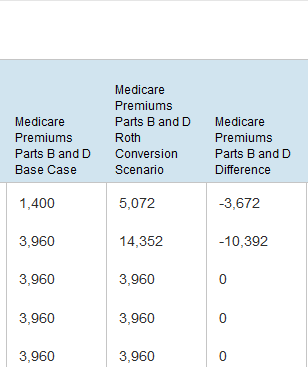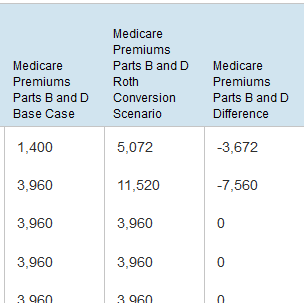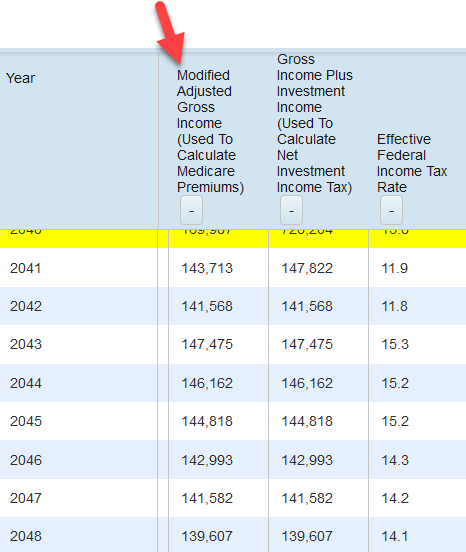Key Points:
- A Roth conversion can be a great idea, but it can also increase Medicare premiums substantially.
- Because Medicare premiums are tied to income it is important to be able to run scenarios on converting to a Roth IRA.
- Using a program like WealthTrace can show you the best timing and amount to convert to a Roth IRA while taking into account Medicare premiums.
So, you're considering switching your regular IRA funds to a Roth IRA. The first thing that probably comes to mind is taxes, right? After all, if taxes weren't a concern, why would we even ponder the switch?
Tax planning for retirement is essential for many people and it should begin before retirement does.
One of the biggest aspects of tax planning for retirement is figuring out if converting money to a Roth IRA makes sense. People must be cautious not to convert too much in a single year, as this could potentially push them into a higher tax bracket or result in a larger tax bill than they’re comfortable with.
For those of you who are currently receiving Medicare Part B or will be within the next two years, it's crucial to understand that converting an amount that results in income just $1 over the threshold could lead to thousands of dollars in additional Medicare Part B costs.
IRMAA and Medicare Premiums
Before we delve into the details and their potential implications, let's revisit some key tax terms:
Gross Income: This encompasses all earned and unearned income, including wages, dividends, capital gains (both short-term and long-term), business income, and retirement distributions.
Adjusted Gross Income (AGI): This is your gross income minus allowable adjustments, which often include individual retirement account (IRA) and self-employed retirement plan contributions, half of the self-employment taxes paid, and premiums for self-employed health insurance, student loan interest, and alimony payments.
Modified Adjusted Gross Income (MAGI): This is essentially your AGI, but without certain adjustments, and includes tax-exempt interest income. Some of the items that were used to reduce gross income when calculating AGI (or that maybe weren’t counted in the first place) are added back in.
Taxable Income: Your AGI minus either the standard deduction or total itemized deductions. This is the income Uncle Sam taxes and it determines your tax bracket.
When contemplating a switch from traditional IRA or 401(k) funds to a Roth IRA, most retirement savers mainly think about taxable income. The more we convert, the higher our taxable income, and the more income taxes we owe. So, the idea is usually to aim for "filling up" whatever room is left in a tax bracket with Roth conversions while avoiding the next tax bracket.
Let's use a retired, married couple as an example. Both spouses turned 65 in January, both enrolled in Medicare Part A and B, and they usually take a standard deduction. They decided two years ago to fill up the 24% bracket with the help of Roth conversions, which means they wanted to generate an AGI of $375,000. To achieve this, they converted a massive $200,000.
However, upon enrolling in Medicare Part B, they found that they each have a Medicare Part B premium of $527.50 per month, along with an additional $70 per month for Part D drug coverage. If they had converted just $9,000 less, their Part B premium would have been $428.60 each, saving them $1,187 each in Part B premiums for the year. Their Part D premiums would have been reduced to $51 per month each, saving an additional $108 each annually.
Medicare Part B and Part D premiums consist of two parts: the “standard” premiums and drug coverage cost and the Income Related Monthly Adjustment Amount (IRMAA). Everyone starts off by paying a standard amount, but those over certain MAGI limits pay more for the same coverages.
For 2023, the standard premium for Medicare Part B is $164.90 per month and the total premium including IRMAA goes as high as $560.50 per month. For Part D, it starts at the stated drug insurance premium and goes as high as an additional $76.40 per month. Remember, this is per person, so for a married couple with both spouses enrolled, these figures generally double.
A Case Study
Let's imagine a scenario where we compare the federal tax brackets and monthly Medicare Part B premiums, bearing in mind that the standard deduction from taxable income is adjusted to MAGI.
Here's something to remember: If you unintentionally exceed a tax bracket, the higher tax rate only applies to the taxable income within that particular bracket. So, if you mistakenly converted an extra dollar into the 32% bracket, you'd only pay 32% tax on that $1, while the remainder of your taxable income would be taxed at lower rates. However, with Medicare IRMAA, as illustrated above, exceeding the same new IRMAA "bracket" by just $1 of MAGI could cost up to $1,295 per person, per year in additional premiums in 2023. Medicare premiums don't work like federal income taxes, where your tax rate is averaged over different brackets. For IRMAA the change is all or nothing.
In this example we have a couple that is wanting to convert $900,000 from a traditional IRA to a Roth IRA over two years. They are already receiving Medicare.
In WealthTrace you can run Roth conversion scenarios and see exactly what your projected Medicare premiums will be.

You can see above that this couple converted so much that they ended up paying the maximum for Medicare in one year. But if they would have just converted $5,000 less they could have reduced their premiums substantially.

WealthTrace even displays the income (MAGI) used for Roth conversions in every year.

It’s important to point out that IRMAA amounts are inflation-adjusted and look back two years, so if you slightly exceed today's threshold when converting this year, there's a chance that two years from now you might fall below the threshold due to inflation adjustments.
Better Safe Than Sorry
In practice, conversions are usually not exactly to the penny of MAGI or taxable income targets, and many people leave some room for error when converting. This means you might opt to convert slightly less than what you need to reach your target income, in case your total income for the year ends up being a bit higher than expected. Remember, conversions can't be "undone" through recharacterization, under the Tax Cuts and Jobs Act.
Imagine making a Roth conversion that puts you slightly over the IRMAA threshold, leading to an increased IRMAA for such a small "extra" conversion amount. This scenario deserves attention, especially when planning to convert "through" the 22%, 24%, or 35% bracket. Simply put, if you plan on converting up to the 24%, 32%, or 37% tax bracket, don't lose sight of Medicare IRMAA and MAGI amounts.
Do you know if and how much you should convert to a Roth IRA? To find out, sign up for a free trial of WealthTrace and get started on your retirement planning.